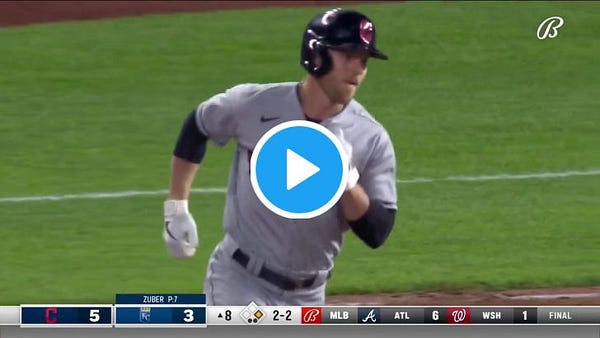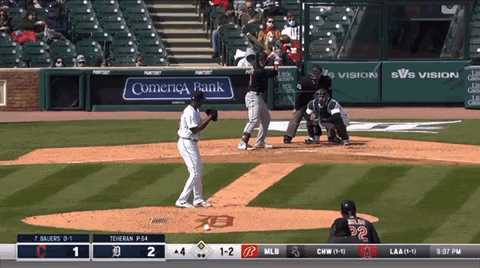Jake Bauers and the chase for that feel-good feeling
Life isn’t fair.
But that doesn’t mean we shouldn’t try. No, that doesn’t generate the click-bait sort of content that moves the needle, but you can find enough panic porn elsewhere if that’s what you’re really seeking. No, Jake Bauers, not that sort of ... never mind.

Jokes aside, let’s talk Bauers, who clubbed a two-run, pinch-hit bomb on Tuesday.
Now that half of the audience is gone, let’s talk more precisely about the disconnect between his expected production and his actual production. His expected stats — the sort of expectation about his production created from his exit velocity, launch angle, strikeouts and walks — have painted a different portrait than the slash line that resembles finger-paintings hanging outside a kindergarten classroom (.200/.280/.311).
Baseball Savant makes this an easy exercise, giving us a nice, tidy expected weighted on-base average (xwOBA), based on his quality and frequency of contact, to compare against his actual wOBA. Just 10 qualified hitters (including teammate Cesar Hernandez) own a larger undesirable gap between the two than Bauers, who has generated a .347 xwOBA compared to a .253 wOBA.
Too complicated? Let’s simplify. Bauers is hitting .200 this year. Based on the quality of his contact and strikeouts, he should be closer to .280 with a .458 slugging, per Statcast (though I do wonder if expected slugging will need additional tweaks now that MLB has made changes to the ball).
And initially, that tells that two things.
Bauers has been unlucky!
The expected production is … a little better than league average (.328 in 2021).
So, here is our chance to be fair.
Yes, Bauers should have better stats — at least based on how he’s hit the ball. His hard-hit rate (percentage of balls hit 95 mph or harder) is 8.6 percentage points higher than his career rate of 35.2. His max exit velocity (110.1 mph) is in the top 26 percent in baseball. His launch angle has found itself in the sweet spot 46.9 percent of the time, 14 percentage points higher than his career rate.
Additionally, while the walks dipped early, the rate (9.8 percent) has risen closer to his career mark (12.1). Those need to come for his full offensive profile to be realized.
And yet, to keep things centered where they need to be, it’s still only suggests a slightly above-average expected outcome, which, yes, is far better than the 63 wRC+ he carried into Wednesday night (100 is league average), but we’re also not suggesting that he’s done anything to emphatically answer if he’s the first baseman of the future.
Right now, he’s doing enough to survive — and many reading this have probably already made up their mind. And if you’re in that camp, I can hardly blame you. We have nearly 900 plate appearances to fall back on now, and at his best, Bauers has been fighting to keep his head above league-average water. I can’t say that we’ve seen anything that suggests the Indians would eventually lament cutting ties.
Much of what has been noted about the 25-year-old first baseman remains true, including my point that Bauers’ best skill — his ability to draw walks and control the zone — can only thrive if the left-handed hitter gives opposing pitchers a reason to fear living in the strike zone, and the 55.2 percent zone percentage suggests they aren’t all that worried. It’s been enough for many, including myself, to be OK with, at the very least, a reduction in playing time.
However, that isn’t what really interests me at the moment.
I want to know why things don’t align.
We started by looking at his hard contact — those balls hit 95+ mph. He’s had 14 of those events so far, collecting five hits for a batting average of .357. His expected batting average on those, according to Statcast, is .449.
Aha! … Wait, in samples this small, that means maybe one or two additional hits. Sure, when your batting average is .200, you’ll take all the missing knocks you can get. But that really doesn’t explain what’s going on here. So, deeper, we dig.
It hasn’t just been poor luck on the well-struck balls. Bauers’ contact below 95 mph has been even more “unlucky” in terms of the gap between his wOBA and xwOBA, not that this is a contact area in which you strive to live.
Balls hit hard are hopeful to create more damage, especially if they’re in the air. Just two have been on the ground, where one, as you’d typically expect, has been a hit. Two more have been pop ups. Those might as well be strikeouts. But overall, those hard-hit balls suggest an expected slugging percentage of .970, but he owns a .714 mark.
He might have lost a chance at an extra-base hit when a fly ball to left field on May 2 in Chicago — a ball that featured a 95 mph exit velocity — landed just shy of the warning track for an out. If changes to the ball are taking away opposite field fly ball distance, as some have theorized, that might explain at least one fly ball out.
A big part of that disconnect, though, comes on the first of his two barrels this season.
A barrel is Statcast’s ideal combination of launch angle and exit velocity. Bauers’ second of the season was the ball that went for a dip in Kansas City’s fountains. But the first came in Game 2 of the young season in Detroit. Despite hitting a ball that could have been a home run in 13 parks, according to Baseball Savant, the scorched drive was turned into an out by Nomar Mazara.
That’ll hurt the slugging percentage (and your ego).
But that’s still only two barrels this year, a 6.3 percent rate — almost exactly his career mark. The increased rate of hard contact hasn’t lined up with the ideal launch angle to generate the perfect contact for which you’re looking. For that reason, the encouraging trends of hard-hit balls hasn’t led to much real destruction.
That’s not to say that more can’t come, particularly if he continues to manage harder contact — if you’re doing nothing else, do that — but we haven’t seen it blended yet, which keeps him a lot closer to being … just kinda OK below the surface … and raises the possibility for some of his hits to be impacted by defense, ballpark or luck.
Otherwise, his ceiling is going to remain somewhere around average, due to the lack of truly damaging base hits. And you’ll take average compared to the brutal alternative. But that’s not really a goal when talking about first base production.
This all comes back to the original point: Fairness.
Has Bauers deserved a better fate this year? Yes. Has it been enough to warrant a little longer look from the organization’s standpoint? Apparently, also yes. Have we seen enough to justify a change in the larger narrative? Not really, no.
At least not yet.
But I’m trying to be fair.




I feel like Im in the extreme minority for wanting Bauers to succeed. There's something about having a first baseman who can produce a 110 WRC+ with a decent OBP and score from 2nd on a single, that intrigues me. But I also admit that my expectations for offensive production from much of the lineup is very low. In any case, great read!